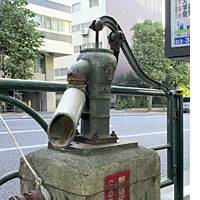Dear Alice:
I was startled the other day, while walking in Shinjuku, to see an old-fashioned water pump, the type with a handle pushed by hand. It was on the sidewalk along a major street, up against a guardrail and half hidden by a rusty bicycle, but if the handle is pumped water comes out. What the heck is a pump doing in such a built-up area?
Louise M., Tokyo
Dear Louise,
That's a te-oshi pompu (hand-operated pump) and you were lucky to spot one. For a long time, hand pumps have been disappearing from city neighborhoods. But in the last 10 years they've made something of a comeback, largely for practical reasons.
The Hanshin Earthquake, which hit Kobe and its vicinity in 1995, revealed the vulnerabilities of modern water supplies. Pipes broke all over the region, leaving 1.26 million households without water, most for several weeks.
That sobering lesson forced disaster planners, particularly in the densely populated Tokyo area, to look for alternate sources of water. They began to revive old-fashioned forms of water supply, including wells and rainwater storage. For example, Kokubunji City, in western Tokyo, has designated 13 wells as mukashi no ido (old-time wells), which are maintained by the city for disaster water supply. Tokyo's Setagaya Ward, meanwhile, subsidizes maintenance and water-quality testing for privately held wells if owners agree to open the wells to the public in case of a disaster.
The thought of an interruption in water service sent me looking for pumps in my own neighborhood. After much skulking around in back alleys, I located three. One, outside a private home, sits over a shallow well that hasn't been used in years, according to the owner, an elderly resident. Another belongs to a large company for emergency access to an underground water storage tank. The third, in a public playground, sits over a tank of municipal water stored specifically for disasters.
To see how things are done in other parts of the city, I headed to shitamachi, the low-lying part of eastern Tokyo. There, the emphasis is on amamizu (rainwater) rather than wells, because the ground water is polluted. Sakae Taniguchi, curator of the Katsushika City Museum, kindly took me to see examples of recently installed hand pumps. I was particularly interested in one outside a neighborhood civic center where rainwater is collected on the roof and funneled into an underground storage tank. The water is used for gardening, flushing toilets and cleaning but could also be tapped in case of a disaster.
"We do this at many ward-owned facilities, not only for cost saving and disaster preparedness but also to promote conservation," my guide explained. But awareness of the program was low until the ward installed a hand pump outside the building.
"Now people are interested. They pump the handle when they walk by, and their consciousness is raised," Taniguchi said. "A hand pump is a visual and tactile means of making people think about water and the need to conserve it."
Well said. And well proven by your inquiry, Louise. If you hadn't spotted that old hand pump, you would not have sent in your question and we might never had had this opportunity to think about alternative sources of water. Thank you.
Last month I invited readers to come up with silly boat names ending in -maru. Jay B. in New York City sent in "Here 2 Day, Gone 2-maru." And from loyal reader Diane O. in Redmond, Wash.,: the "Abu-no-o-maru." And from Bob R. in Tokyo: the "Pas-maru." Meanwhile, Douglas Brooks, author of "The Tub Boats of Sado Island" (Kodo Cultural Foundation, 2003) sent in a photo of a taraibune. I think you will agree it is the quintessential "maru boat."




